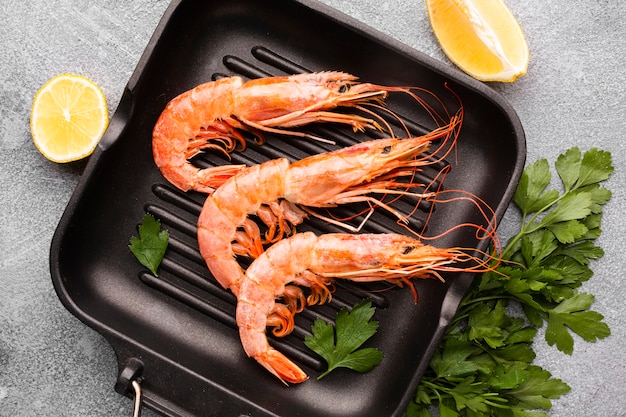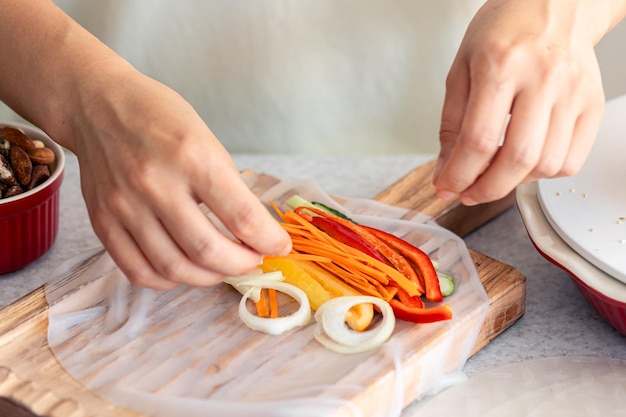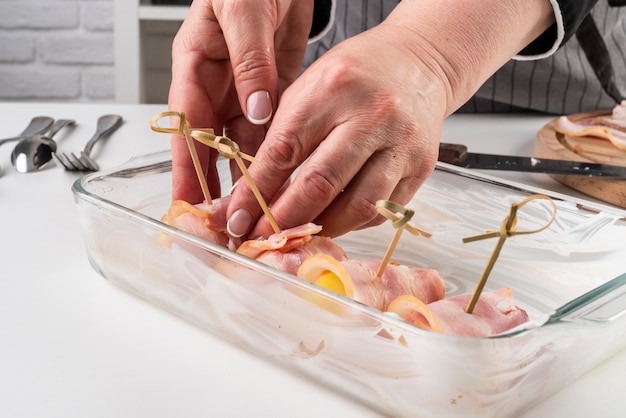Hey there, shrimp enthusiasts! As a seasoned chef with a lifelong love for all things seafood, I've dedicated countless hours to mastering the art of cooking shrimp. From simple pan-fried beauties to elaborate curries, I've learned a thing or two about these delightful crustaceans. So, grab a comfy spot, because you're about to embark on a culinary adventure that'll transform your shrimp game from "ordinary" to "absolutely outstanding!"
(Part 1)
The Shrimpy Saga: Choosing the Right Crew

Let's face it, the foundation of any great dish lies in its ingredients. And when it comes to shrimp, choosing the right ones is crucial for a truly delicious experience.
The "Freshness" Factor: A Sensory Delight
Imagine the scent of the ocean breeze, the tang of salt, and the sweet aroma of freshly caught seafood. That's what your shrimp should smell like. You want shrimp that possess a slightly sweet, briny scent, devoid of any fishy or ammonia-like odors. A lingering fishy smell is a clear indication that they've seen better days.
Size Matters: Finding Your Perfect Shrimp
From delicate cocktail shrimp to majestic jumbo prawns, the world of shrimp is incredibly diverse. The size you choose depends on your intended dish and personal preference. For a delicate salad, smaller shrimp will work beautifully. But for a hearty stir-fry or paella, you'll want those larger, more substantial crustaceans.
Frozen vs. Fresh: A Culinary Debate
Now, this is a topic that sparks passionate opinions. Personally, I believe that high-quality frozen shrimp can be just as delicious as fresh. They are often more convenient and readily available, especially in areas where fresh shrimp isn't always easy to find. The key is to choose frozen shrimp that hasn't been thawed and refrozen, ensuring that they maintain their texture and flavor.
My Secret Shrimp Hunting Grounds
As a true foodie, I'm always on the lookout for the best quality shrimp. Here are my favourite places to find those perfect crustaceans:
- Local Fishmongers: These folks offer a personal touch and expert advice that you won't find anywhere else. They are happy to tell you about the origin of their shrimp and offer guidance on the best ways to cook them.
- Farmer's Markets: This is where you'll discover seasonal, locally-sourced shrimp, often at prices more appealing than your average supermarket.
- High-end Supermarkets: For the crème de la crème, head to a supermarket with a dedicated seafood counter. They usually have a wider variety of shrimp, including some rarer and pricier breeds.
(Part 2)
Shrimp-tastic Preparation: Getting Ready to Cook

You've chosen your shrimp, now it's time to prepare them for their culinary transformation.
Deveining: A Necessary Ritual?
The dark vein running along the back of the shrimp is the intestinal tract, sometimes called the "sand vein." While it's perfectly safe to eat, some find it off-putting. Whether you devein your shrimp is a personal choice. If you're aiming for a clean, elegant presentation, deveining is a good idea. But for a rustic look, it's not a deal-breaker.
How to Devein with Precision
If you're feeling adventurous, here's how to devein shrimp like a seasoned chef:
1. Hold the Shrimp: Gently hold the shrimp in your dominant hand, with the head pointing away from you.
2. Use a Sharp Knife: With your other hand, use a sharp paring knife to make a shallow cut along the back of the shrimp, running parallel to the vein.
3. Remove the Vein: Carefully lift and remove the dark vein using the tip of the knife. You can also use a small skewer or toothpick to gently extract it.
4. Rinse Thoroughly: Rinse the shrimp under cold water to remove any residual bits of the vein and debris.
Shell On or Off: A Culinary Choice
This decision largely depends on your chosen dish. If you're grilling or barbecuing, keeping the shells on helps to retain moisture and flavor. But for pan-frying, sautéing, or adding shrimp to a stir-fry, removing the shells is usually preferred.
Patting Dry: The Secret to Crispiness
One of the most crucial steps is to pat your shrimp dry. This helps to prevent steaming in the pan and ensures a lovely, crispy finish.
(Part 3)
Pan-fried Perfection: Shrimp with a Golden Crust

pan-fried shrimp is a timeless classic and one of my personal favourites. It's simple to make, versatile, and incredibly delicious.
The Perfect Pan: A Kitchen Essential
A good quality cast-iron pan is a kitchen essential, perfect for pan-frying shrimp. The heavy bottom ensures even heat distribution, resulting in a beautiful golden crust.
Heating Up the Oil: A Balanced Approach
Don't overcrowd the pan. Ensure enough space between the shrimp so they cook evenly. The oil should be hot enough to sizzle, but not smoking. If it's too hot, the shrimp will burn before they have a chance to cook through.
The Flip: A Delicate Touch
Once the shrimp are golden brown and cooked through on one side, flip them over gently. They should only need a minute or two on the other side.
Seasoning Savvy: Elevating the Flavor
Seasoning your shrimp is essential for adding depth of flavor. Here are some of my go-to combinations:
- Classic Salt and Pepper: Simple yet effective, this combination allows the natural shrimp flavor to shine.
- Garlic and Herbs: A fragrant blend that adds a touch of Mediterranean magic.
- Spicy Chili: Perfect for those who like a bit of heat.
- Lemon and Butter: A classic combination that elevates any shrimp dish.
Don't Overcook: The Key to tender shrimp
The secret to perfect shrimp is knowing when to stop. Overcooked shrimp become tough and rubbery. Once they are opaque and slightly curled, they are ready to be enjoyed.
(Part 4)
Beyond the Pan: Exploring Other Cooking Methods
While pan-frying is a fantastic method for shrimp, there are many other ways to cook these delicious crustaceans.
Grilling Goodness: A Smoky Delight
Shrimp on the grill? It's a match made in heaven! The smoky flavor from the grill adds a whole new dimension to these little beauties.
- Marinate Magic: Before grilling, try marinating your shrimp in a mixture of olive oil, lemon juice, garlic, and herbs for a burst of flavour.
- Skewer Savvy: Thread your shrimp onto skewers for easy grilling and to prevent them from falling into the flames.
- Don't Overcook: As with pan-frying, it's essential to keep an eye on your shrimp and avoid overcooking.
Boiling Bliss: A Simple and Delicious Method
Boiling is a straightforward way to cook shrimp, perfect for adding to salads or soups.
- Seasoned Water: Bring a pot of salted water to a rolling boil, adding a few bay leaves and black peppercorns for extra flavor.
- Cook Time: Add the shrimp to the boiling water and cook for 2-3 minutes, or until they turn pink and opaque.
- ice bath: Immediately transfer the cooked shrimp to an ice bath to stop the cooking process and prevent them from overcooking.
Oven-baked shrimp: A Low-Maintenance Option
Baking shrimp in the oven is a great option when you want to cook a larger batch or don't have a lot of time on your hands.
- Pre-heat Power: Preheat your oven to 400°F (200°C).
- Sheet Pan Simplicity: Line a baking sheet with parchment paper for easy cleanup and place the shrimp in a single layer.
- Bake Time: Bake for 8-10 minutes, or until the shrimp are cooked through and slightly browned.
(Part 5)
Shrimpy Sidekicks: Complementary Dishes and Sauces
Now that you've mastered the art of cooking shrimp, let's explore some fantastic ways to complement those delicious morsels.
Salad Partners: A Fresh and Healthy Option
Shrimp are a perfect addition to salads, adding a protein boost and a delicious seafood flavor.
- Classic Caesar: A traditional Caesar salad with pan-fried shrimp is a classic winner.
- Mediterranean Delight: Combine grilled shrimp with fresh tomatoes, cucumbers, olives, and feta cheese for a Mediterranean-inspired salad.
- Asian Fusion: Create a vibrant Asian-style salad with shrimp, shredded carrots, cabbage, and a light sesame dressing.
Pasta Powerhouses: A Filling and Flavorful Option
Shrimp are incredibly versatile and work beautifully with pasta.
- Garlic Butter Bliss: Sauté shrimp with garlic and butter and toss with your favorite pasta for a simple and satisfying meal.
- Tomato Tango: Combine shrimp with a rich tomato sauce, fresh basil, and Parmesan cheese for a classic Italian dish.
- Spicy Stir-Fry: Whip up a quick and tasty stir-fry with shrimp, vegetables, and your favorite chili sauce for a flavorful Asian-inspired dish.
Sauce Savvy: Adding Extra Depth of Flavor
Sauces can take your shrimp dish from good to phenomenal.
- Lemon Butter Delight: Melt butter with lemon juice, garlic, and herbs for a simple and elegant sauce.
- Spicy Chili Magic: Combine chili sauce, soy sauce, garlic, and ginger for a fiery and flavorful sauce.
- Creamy Garlic Sauce: Whisk together cream, garlic, Parmesan cheese, and a touch of lemon juice for a rich and creamy sauce.
(Part 6)
Shrimpy Adventures: Recipe Inspiration and Variations
Now that you've mastered the basics, let's explore some delicious and inspiring shrimp recipes to ignite your culinary creativity.
Classic shrimp scampi: A Timeless Favorite
Shrimp scampi is a beloved Italian dish that's easy to make and incredibly delicious. The key is to create a rich and flavorful garlic butter sauce that perfectly complements the tender shrimp.
Ingredients:
- 1 pound shrimp, peeled and deveined
- 4 tablespoons butter
- 4 cloves garlic, minced
- 1/4 cup dry white wine
- 1/4 cup chopped fresh parsley
- 1/4 teaspoon red pepper flakes (optional)
- Salt and black pepper to taste
- 1 pound linguine or spaghetti pasta
Instructions:
1. Cook the pasta according to package directions.
2. While the pasta is cooking, melt the butter in a large skillet over medium heat.
3. Add the minced garlic and cook for about 1 minute, or until fragrant.
4. Pour in the white wine and bring to a simmer.
5. Add the shrimp, parsley, and red pepper flakes (if using).
6. Cook for 2-3 minutes, or until the shrimp are cooked through.
7. Season with salt and pepper to taste.
8. Drain the pasta and add it to the skillet with the shrimp and sauce.
9. Toss to combine and serve immediately.
Spicy shrimp tacos: A Fiesta in Your Mouth
These spicy shrimp tacos are a crowd-pleaser and a perfect way to spice up your taco night. The combination of juicy shrimp, vibrant pico de gallo, and a creamy avocado crema is simply irresistible.
Ingredients:
- 1 pound shrimp, peeled and deveined
- 2 tablespoons olive oil
- 1 tablespoon chili powder
- 1 teaspoon cumin
- 1/2 teaspoon smoked paprika
- 1/4 teaspoon cayenne pepper (optional)
- Salt and black pepper to taste
- 12 corn tortillas
- 1/2 cup pico de gallo
- 1 avocado, mashed
- 2 tablespoons sour cream
- 1 tablespoon lime juice
- 1/4 cup chopped cilantro
Instructions:
1. In a bowl, combine the olive oil, chili powder, cumin, smoked paprika, cayenne pepper (if using), salt, and pepper.
2. Add the shrimp and toss to coat.
3. Heat a large skillet over medium heat.
4. Add the shrimp and cook for 2-3 minutes per side, or until cooked through.
5. While the shrimp are cooking, warm the tortillas in a dry skillet or microwave.
6. To make the avocado crema, combine the mashed avocado, sour cream, lime juice, and cilantro in a bowl.
7. Assemble the tacos by filling the tortillas with shrimp, pico de gallo, and avocado crema.
8. Serve immediately.
(Part 7)
Shrimpy Leftovers: Turning leftover shrimp into a Feast
Let's be honest, sometimes you just end up with leftover shrimp. But don't let those tasty morsels go to waste! Here are some ideas to put them to good use.
Salad Sensation: A Light and Refreshing Option
Chop up those leftover shrimp and add them to a fresh salad for a tasty and protein-packed lunch or dinner.
Soup Stars: Adding a Seafood Touch
Shrimp can add a delicious seafood flavor to your favorite soups. Simply add them to a pot of simmering soup for the last 5-10 minutes of cooking.
Pasta Power: A quick and easy meal
Leftover shrimp can easily be incorporated into a quick and easy pasta dish. Simply toss them with your favorite pasta sauce and cooked pasta for a satisfying meal.
Rice Rhapsody: A Flavorful and Versatile Option
Shrimp can be added to rice dishes for a delicious and satisfying meal. Mix them with fried rice, or add them to a bed of steamed rice for a simple and flavorful dish.
(Part 8)
FAQs: Unveiling the Mysteries of shrimp cooking
Now that you've got the lowdown on all things shrimp, let's tackle some common questions that might be swirling in your mind.
1. How do I know if shrimp is cooked properly?
Cooked shrimp will be opaque and slightly curled. They should also have a firm texture. Avoid overcooking, as it will make the shrimp tough and rubbery.
2. Can I freeze leftover cooked shrimp?
Absolutely! To freeze cooked shrimp, simply place them in an airtight container or freezer bag and freeze for up to 3 months. When ready to use, thaw them in the refrigerator overnight.
3. How do I prevent shrimp from sticking to the pan?
Make sure the pan is hot enough before adding the shrimp, and use enough oil to create a light coating on the bottom of the pan. You can also try lightly dusting the shrimp with cornstarch or flour to prevent sticking.
4. What is the best way to store fresh shrimp?
Store fresh shrimp in the refrigerator for up to 2 days. Wrap them tightly in plastic wrap or place them in an airtight container.
5. Is there a difference between shrimp and prawns?
While often used interchangeably, shrimp and prawns are actually different types of crustaceans. Prawns tend to be larger than shrimp and have a more curved body. They also have a slightly different flavor.
Additional Tips for Perfect Shrimp:
Invest in a good quality shrimp thermometer: This will ensure that your shrimp are cooked to perfection every time.
Don't be afraid to experiment with different seasonings and sauces: Shrimp is incredibly versatile and can be paired with a wide variety of flavors.
Don't overcook: Overcooked shrimp are tough and rubbery. Cook them until they are opaque and slightly curled.
Enjoy! There's nothing quite like the taste of perfectly cooked shrimp.
Everyone is watching

Prime Rib Roast Cooking Time Chart: Per Pound Guide
Cooking TipsPrime rib roast. Just the name conjures images of lavish dinners, crackling fires, and hearty laughter. It’s ...

How Long to Bake Potatoes in the Oven (Perfect Every Time)
Cooking TipsBaked potatoes are a staple in my kitchen. They're incredibly versatile, delicious, and surprisingly easy to m...

Perfect Rice Every Time: The Ultimate Guide to Cooking Rice
Cooking TipsAs a self-proclaimed foodie, I've always been a bit obsessed with rice. It's the foundation of countless cuisi...

The Ultimate Guide to Cooking Asparagus: Tips, Techniques, and Recipes
Cooking TipsAsparagus. The mere mention of this spring delicacy conjures up images of vibrant green spears, crisp and burs...

Ultimate Guide to Cooking the Perfect Thanksgiving Turkey
Cooking TipsThanksgiving. Just the word conjures up images of overflowing tables laden with delicious food, the scent of r...
